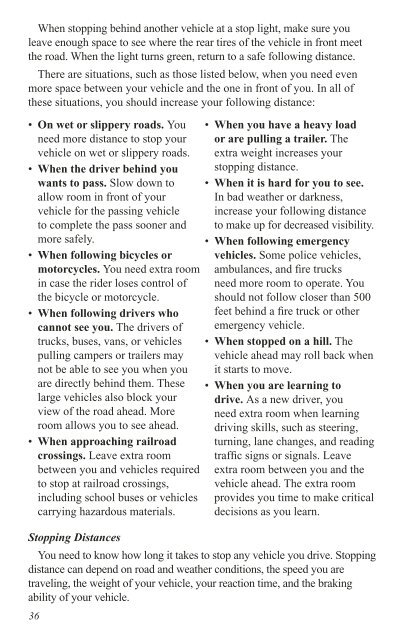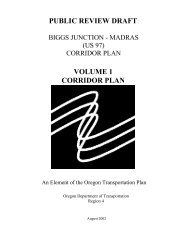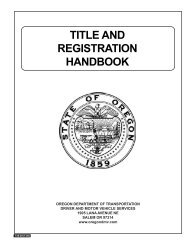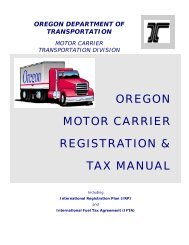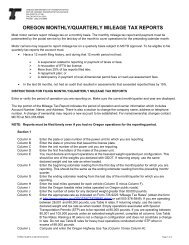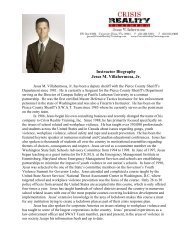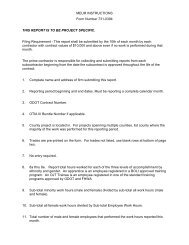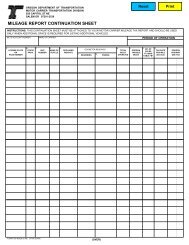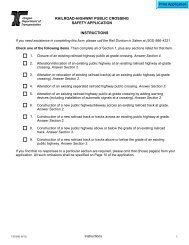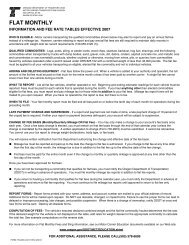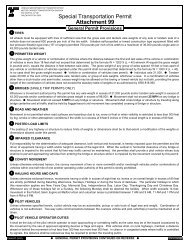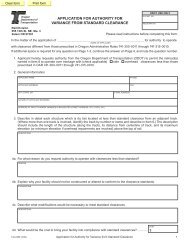2013 Oregon Driver Manual - Oregon Department of Transportation
2013 Oregon Driver Manual - Oregon Department of Transportation
2013 Oregon Driver Manual - Oregon Department of Transportation
You also want an ePaper? Increase the reach of your titles
YUMPU automatically turns print PDFs into web optimized ePapers that Google loves.
When stopping behind another vehicle at a stop light, make sure you<br />
leave enough space to see where the rear tires <strong>of</strong> the vehicle in front meet<br />
the road. When the light turns green, return to a safe following distance.<br />
There are situations, such as those listed below, when you need even<br />
more space between your vehicle and the one in front <strong>of</strong> you. In all <strong>of</strong><br />
these situations, you should increase your following distance:<br />
• On wet or slippery roads. You<br />
need more distance to stop your<br />
vehicle on wet or slippery roads.<br />
• When the driver behind you<br />
wants to pass. Slow down to<br />
allow room in front <strong>of</strong> your<br />
vehicle for the passing vehicle<br />
to complete the pass sooner and<br />
more safely.<br />
• When following bicycles or<br />
motorcycles. You need extra room<br />
in case the rider loses control <strong>of</strong><br />
the bicycle or motorcycle.<br />
• When following drivers who<br />
cannot see you. The drivers <strong>of</strong><br />
trucks, buses, vans, or vehicles<br />
pulling campers or trailers may<br />
not be able to see you when you<br />
are directly behind them. These<br />
large vehicles also block your<br />
view <strong>of</strong> the road ahead. More<br />
room allows you to see ahead.<br />
• When approaching railroad<br />
crossings. Leave extra room<br />
between you and vehicles required<br />
to stop at railroad crossings,<br />
including school buses or vehicles<br />
carrying hazardous materials.<br />
36<br />
• When you have a heavy load<br />
or are pulling a trailer. The<br />
extra weight increases your<br />
stopping distance.<br />
• When it is hard for you to see.<br />
In bad weather or darkness,<br />
increase your following distance<br />
to make up for decreased visibility.<br />
• When following emergency<br />
vehicles. Some police vehicles,<br />
ambulances, and fi re trucks<br />
need more room to operate. You<br />
should not follow closer than 500<br />
feet behind a fi re truck or other<br />
emergency vehicle.<br />
• When stopped on a hill. The<br />
vehicle ahead may roll back when<br />
it starts to move.<br />
• When you are learning to<br />
drive. As a new driver, you<br />
need extra room when learning<br />
driving skills, such as steering,<br />
turning, lane changes, and reading<br />
traffi c signs or signals. Leave<br />
extra room between you and the<br />
vehicle ahead. The extra room<br />
provides you time to make critical<br />
decisions as you learn.<br />
Stopping Distances<br />
You need to know how long it takes to stop any vehicle you drive. Stopping<br />
distance can depend on road and weather conditions, the speed you are<br />
traveling, the weight <strong>of</strong> your vehicle, your reaction time, and the braking<br />
ability <strong>of</strong> your vehicle.


